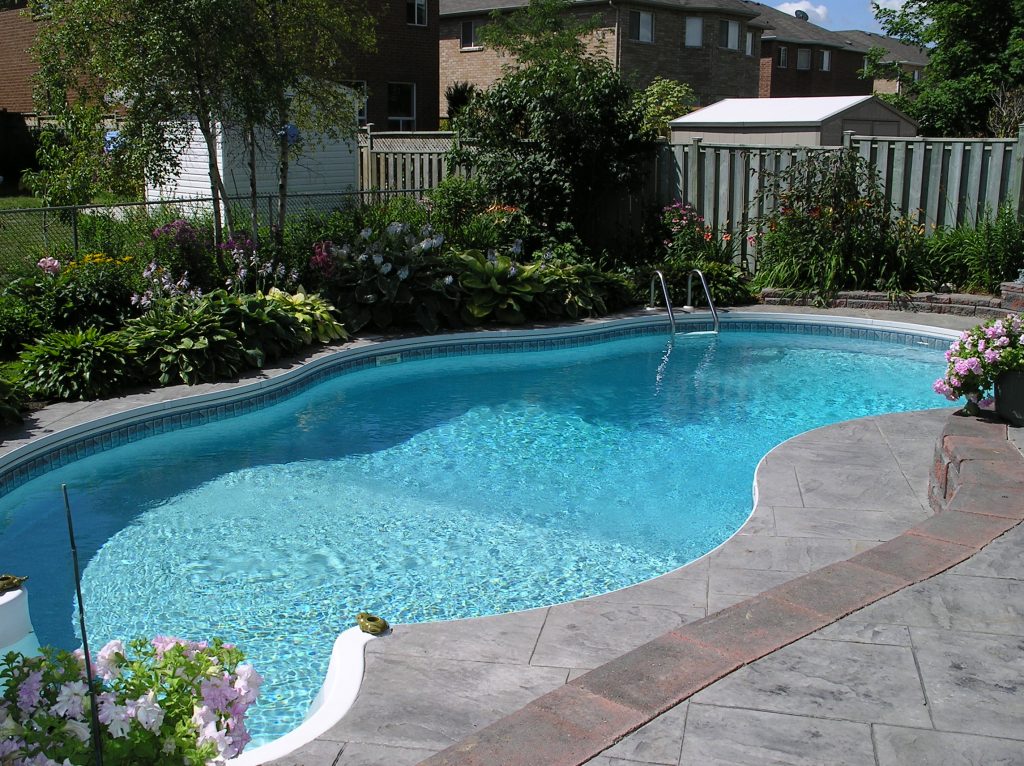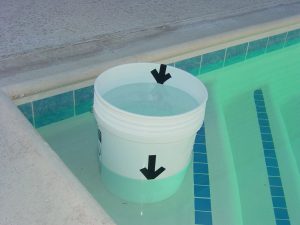Pools are a great way to beat the heat! However, summer weather can do a number on your pool: haboobs deposit dirt, blustery winds deliver shed flowers and leaves, and rain washes yard debris right into your pool. Just like cleaning up after the big July 4th party, your pool needs maintenance to keep the water crystal clear. Besides regular chemicals, your pool’s filter may need an occasional flush, called pool backwashing.
It is important to remember the motto “Only Rain in the Storm Drain” even when performing this maintenance. In many cities or towns, it is a code violation to discharge backwash water from your property into a public right-of-way like an alley, road, or arroyo.
Backwash water may contain chlorine, bromine, algaecides, biocides, water conditioners, stabilizers, and other chemicals that can persist in the environment for a long time. These materials and other pollutants found in backwash water accumulate over time in dry washes and streams, eventually depositing in urban lakes or streams becoming toxic to fish and other aquatic life.
You can do your part to protect the environment
Consider these options to prevent pollutants from entering our waterways:
- Use the backwash to water grass or any area on your property that will allow water to percolate into the ground.
- Many southwest homes already have salt-tolerant plants. Check out this website for more information: http://www.amwua.org/plants
- Backwash pools directly into the private sewer cleanout on your property instead of into the storm gutter.
- If you are on septic and don’t have sufficient area to discharge onto your property, try the following:
- Hire a contractor to pump the pool water into a truck to be hauled offsite. Check the yellow pages or internet for septic disposal companies for this service.
- DO NOT DRAIN OR BACKWASH INTO YOUR CLEANOUT IF YOU ARE ON A SEPTIC SYSTEM.
- Before performing repairs, consult a pool professional to determine if repairs can be made without draining the pool.
Now that you have backwashed your pool, you are probably asking yourself “Why do I have to fill my pool so often?”
First, pools lose water through evaporation. This expected water loss is dependent on sunlight, temperature, wind, humidity, and shading. A typical swimming pool will lose its equivalent water volume in one year — up to 25,000 gallons of water. Along with evaporation, some water is lost through ‘splash out’ and as mentioned above, from backwashing. Also, consider that up to 30 percent of all pools have some type of leak. While pool water evaporation is normal, an abnormal drop in water level may indicate a leak.
Leaks may occur due to a variety of reasons, like holes, tears, or cracks allowing the water to leak undetected under the decking. However, most leaks occur in the pool equipment. Many pools have an autofill device (automatic pool water leveler) to maintain a consistent pool water level. These devices may mask a leak by automatically replacing water lost and thus prevent a visible drop in pool level.
How to Check Your Pool For Leaks
Step One
Check the pool and/or spa autofill for proper operation:
- Take note of the pool water level. The autofill should keep the pool water level at the middle of the skimmer box opening. Too high and water may escape through gaps under the decking at the top of the pool or through the autofill crock (container in which the autofill sits).
- Check the autofill float to see if it can stop the water flow. If your autofill is allowing water to flow through it, gently lift the float to see if the flow stops.
Step Two
Check the pool and/or spa system equipment:
- Note pool level, and then turn on pool equipment. A drop in water level may indicate a leak.
- Visually inspect pool equipment, especially around pipe joints. Crusty, white mineral deposits on pipes may indicate a slow leak.
- Walk around the pool and pool equipment, and walk the path from the water supply line to the pool equipment. Look for any wet spots, small holes, or depressions in the soil, as these might indicate an underground water leak.
Consider a Bucket Test if you suspect a leak in your pool system.
 The Bucket Test
The Bucket Test
- Disable (turn off) the autofill (if present).
- Place a bucket or container on a pool step without submerging it.
- Use a large rock or brick to weigh down the container.
- Fill it with water so it is the same level as the pool water.
- Mark the water level inside the bucket.
- Mark the pool water level on the outside of the bucket.
- Wait at least two to three days to let natural evaporation occur.
- Compare the two water levels:
- If the pool water level (outside mark) dropped more than the bucket’s water level (inside mark), you may have a leak and may want to contact a pool contractor.
- If the level changes are the same, only evaporation has occurred.
9. Resume normal autofill operation.
Watch the bucket test how-to video.
Visit Stormwater Outreach for Regional Municipalities webpage AZSTORM.org to find out more information regarding your municipality’s rules on pool backwashing and other tips to protect our environment. Remember, “Only rain in the storm drain.”
More details on how to care for your pool can be found at these suggested links from the Water – Use It Wisely resources page:
- Pools and Spas: Water Saving Tips and Technologies
- How to Drain or Backwash Your Pool
- Using Swimming Pool Water on Plants
- Saving Water in Swimming Pools: 5 Ways to Cut Evaporation
- Saving Water in Swimming Pools: 5 Ways to Cut Pool Water Loss
- How to Reduce Chemical Use in Your Pool
Water – Use It Wisely is proud to feature guest bloggers who write about topics related to water and water conservation. Justin Bern is a Senior Water Quality Specialist in the Water Resources Department at the city of Scottsdale. He assists city environmental program coordinators to protect drinking water and water reuse infrastructure and maintain compliance with county, state, and federal environmental permits.



 The Bucket Test
The Bucket Test